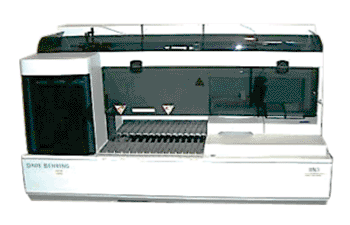Cystatin C Blood Levels Estimate Kidney Function
By LabMedica International staff writers
Posted on 23 Sep 2013
Cystatin C, a newer kidney function marker, is becoming more widely available and in some settings provides improved estimates of kidney function.Posted on 23 Sep 2013
The use of blood levels of cystatin C to estimate kidney function, alone or in combination with creatinine levels, strengthens the association between kidney function and risks of death and end-stage renal disease.

Image: Dade Behring BN II Nephelometer (Photo courtesy of Siemens Diagnostics).
An international team of scientists, known as the Chronic Kidney Disease Prognosis Consortium, based at the Johns Hopkins University (Baltimore, MD, USA) performed a meta-analysis of 11 general-population studies, with 90,750 participants from the USA, Europe, and Australia. They also examined five studies of 2,960 participants with chronic kidney disease for whom standardized measurements of serum creatinine and cystatin C were available.
The team compared the association of kidney function, as calculated by the measurement of creatinine, cystatin C, or the combination of creatinine and cystatin C, with the rates of death, death from cardiovascular causes, and end-stage kidney disease, and they compared kidney disease stages that were classified alternatively by creatinine or cystatin C.
The analyses of using cystatin C demonstrated that the risks associated with declining kidney function emerge when kidney function reaches approximately 85 mL per minute per 1.73 m2, much earlier than the threshold of chronic kidney disease which is 60 mL/min/1.73 m2. In contrast, with creatinine based kidney function estimates, these risks of kidney function cannot be observed until kidney function is below 60 mL/min/1.73 m2, by which time chronic kidney disease has already developed. The kidney function stages categorized by cystatin C were much better at reflecting future risk than were the stages based upon creatinine estimates of kidney function.
Michael Shlipak, MD, MPH, from the University of California (San Francisco, CA, USA) and lead author of the article, said “Clearly cystatin C defines an important preclinical period of reduced kidney function before chronic kidney disease can be diagnosed with creatinine alone, and this period may last one to two decades. Cystatin C allows patients' kidney function to be categorized more accurately; the use of cystatin C in clinical medicine could help us to be more precise in the diagnosis of chronic kidney disease, and in the future to target high-risk patients for treatment in order to prevent chronic kidney disease." The study was published on September 5, 2013, in the New England Journal of Medicine.
Related Links:
Johns Hopkins University
University of California













